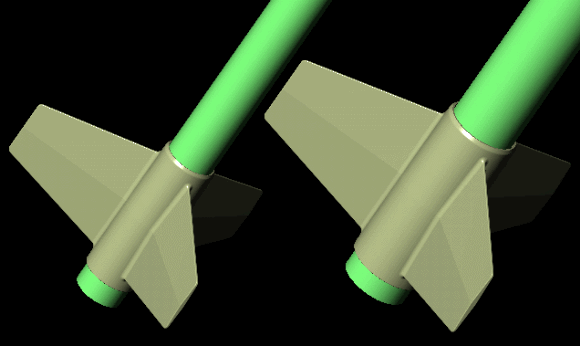| Manufacturer: | Acme Engineering |
"There's really no easier and faster way to build a minimum diameter rocket, and still maintain the construction strength requirements dictated by high power rocket flight dynamics. All the trouble of oversize airframe tubes, individual through-wall fins, centering rings, slotting, fin filleting, and the like are eliminated. The Acme fin canister simply slides onto your airframe tube, and epoxies into place." ACME Aerostructures produces two types of fin canisters along with their launch lugs. These fin canisters, made of Zytel and fiberglass, are very strong and simple as they are one molded piece. They allow for the construction of minimum diameter Rockets with the strength of through the wall construction and then some. These canisters are the closest one can get to the strength and accuracy of alignment of professional sounding rockets without the use of metals. The fin units come in two sizes; 38mm for most 38mm airframes and 54mm for 54mm airframes. These fin canisters have plenty of room even for ‘frames with thick layers of fiberglass or Kevlar. They are pretty light (by high-power standards) at .4 lbs., and .75 lbs. respectively. While the airfoils of the fins are pretty thick (the 38mm starts out at .162 in. at the edge and becomes .325 in. at the center while the 54mm canister can be .4in at the center) the diamond type airfoil minimizes the drag and is good for flights over mach. The sleeve length is enough to provide surface area for epoxy and stability during the highest of aerodynamic loads.
When I first got my 38mm fin unit, I was surprised by the weight and strength (I was a low power Estes guy at the time) and could only dream of the flights that would demand fins like this. The price (around $30) was a bit high but it is worth the quality. There was significant residue from the molding process (I don't really know if I should call these seams or flashing) that required a great deal of sanding. The shape was pretty clean overall, the alignment seemed good to the degree (120). I first placed the canister on a small rocket, but found that the rocket was too short for such a heavy canister. I next placed the canister on a 36in., 38mm phenolic airframe but again found that I would have been wasting the potential for speed with this rocket as well (this canister was built for speed and altitude!). I finally put the canister at the end of a 72in. all fiberglass, minimum diameter rocket called the "custom dart" This rocket can take any 38mm motor in the world, but can still go up on a G motor as well. I have put the rocket up on G125 motors three times. The first flight ended in a separation and a ballistic recovery. The fin canister and airframe landed on rocks really hard. I expected to recover pieces of the rocket from my position at the launch control but was glad to find only minor damage. A few chips in the fin canister were sanded down, and the rocket was ready to go. This type of recovery would have damaged any rocket out there but with the Acme fin unit and the fiberglass airframe, the rocket will live to fly again. At RATS (2000), the thing went up on an I357T-10. That flight was like a mini Kosdon; 0 mph. to 600 in 1 sec., 6000 ft. (Unfortunately it was lost in some high grass, but what a way to go!) The Acme fin canisters are a great solution to the issue of strength in minimum diameter rockets. If I had to rate them, on a scale of 1 to 5, I would give a 5. These are the best fin canisters around. I am hoping that ACME will make a 29mm version soon (I200W, I800 etc.) The VB Extreme 54 with the 54mm fin canister could handle the K250, the K1100, the K1050, or even the L750. Altitudes could probably approach those that 747 pilots talk to their passengers about. To learn more about the Acme Fin Canisters including a list of retailers, you can go their web site. UPDATE 6/00: Just as an update, I have recently purchased the materials to produce a 54mm version of the old "custom dart". This rocket, built to fly on motors from the G80T-4 up to the L750-15 (including the K1500T-15, the K1050W (p), and the K1100T-10)with flights to 16 or 18K. I got the 54mm fin can and found that it was just as easy to use and as strong.
 |
 |
R.T. (December 1, 2000)
M.J.W. (June 1, 2001)
J.R. (June 26, 2005)
Sponsored Ads
 |
 |












unknown (November 1, 2000)